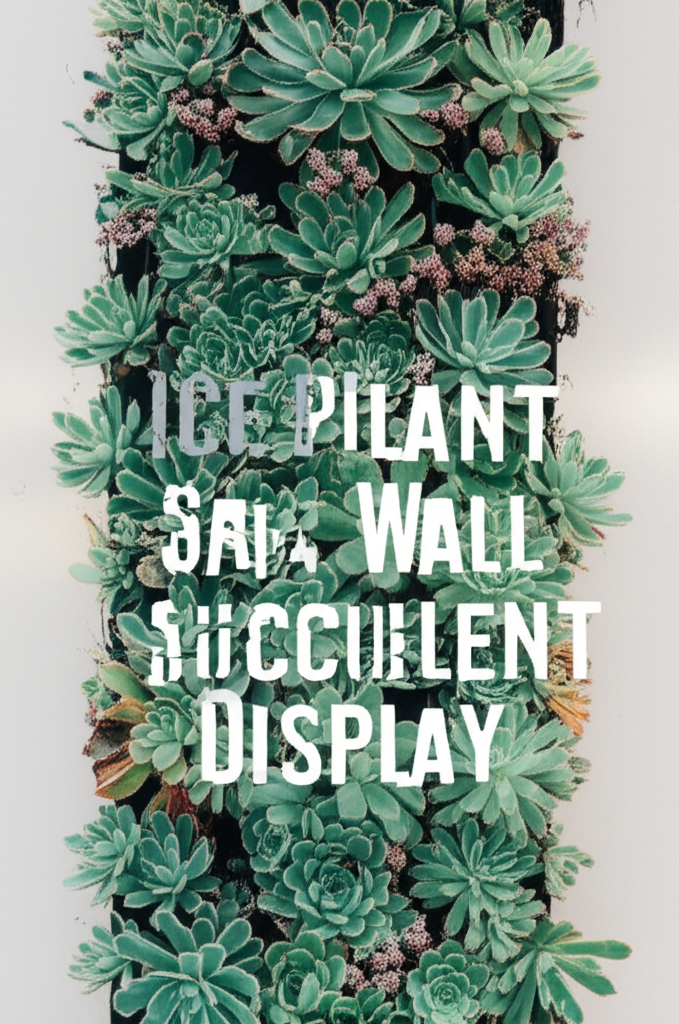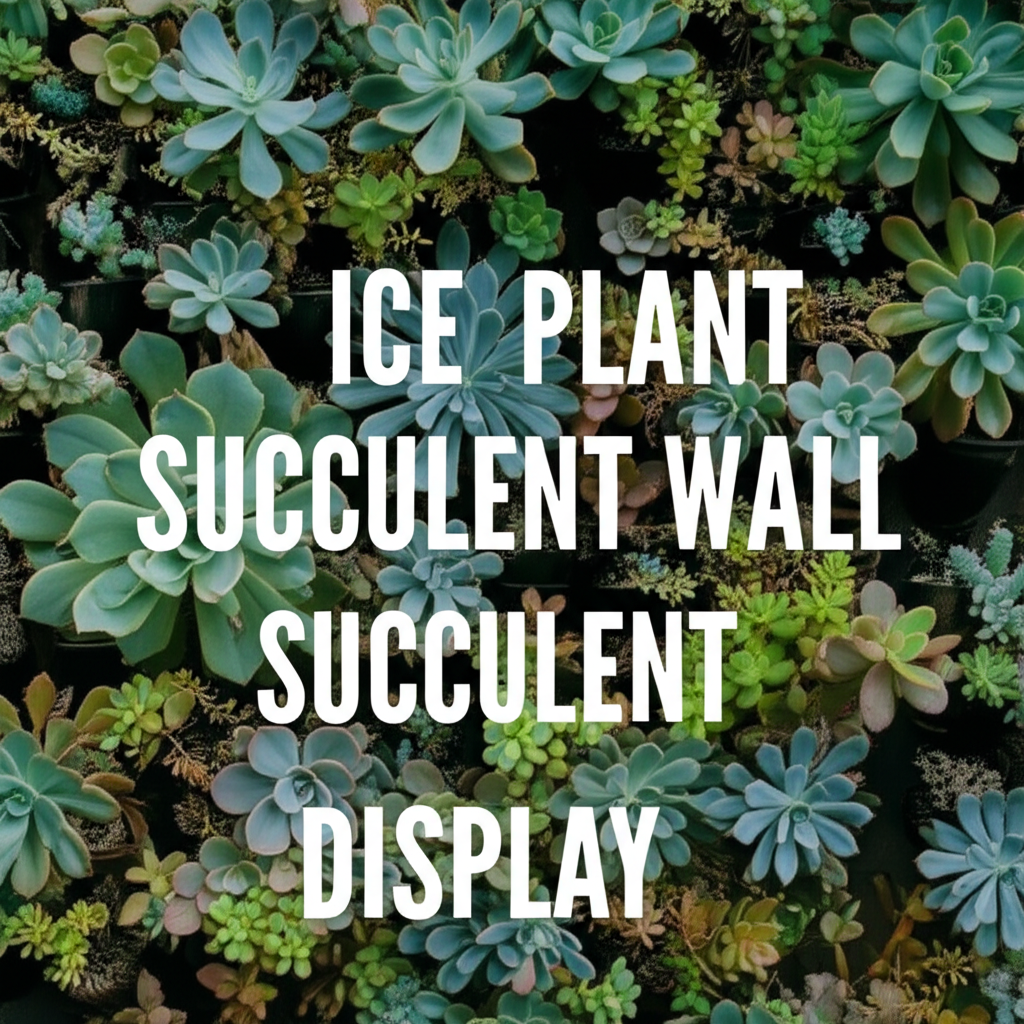The Allure of Living Walls: Bringing Nature Indoors
Living walls, also known as vertical gardens, are rapidly transforming interior and exterior spaces. They offer a unique way to introduce greenery, purify air, and create captivating focal points. Among the diverse array of plants that can adorn these living canvases, succulents, particularly the vibrant Ice Plant varieties, stand out for their resilience, aesthetic appeal, and low-maintenance nature. This guide delves into the art and science of creating a breathtaking ice plant succulent vertical wall display, a project that promises to bring a touch of vibrant, living art into your home or business.
Why Ice Plants for Your Vertical Display?
Ice plants (family Aizoaceae), with their distinctive succulent leaves that often glisten with epidermal bladder cells, are exceptionally well-suited for vertical displays. These specialized cells, resembling tiny ice crystals, not only give them their name but also help them collect moisture from the air, a crucial adaptation for arid environments and a beneficial trait for a contained vertical garden.
Several key characteristics make ice plants ideal for this application:
- Drought Tolerance: Like most succulents, ice plants require minimal watering, reducing the risk of over-saturation, a common pitfall in vertical gardening.
- Shallow Root Systems: Their roots generally stay close to the surface, making them perfect for the limited soil depth of most vertical gardening systems.
- Variety in Form and Color: From trailing varieties that cascade elegantly to compact forms that create a dense tapestry, ice plants offer a stunning range of textures and colors, including vibrant pinks, yellows, oranges, and greens.
- Sunlight Adaptability: Many ice plant species thrive in bright, indirect light, making them suitable for a variety of indoor and outdoor locations.
Key Ice Plant Varieties for Vertical Gardens
When selecting ice plants for your vertical display, consider species known for their compact growth habits or attractive trailing tendencies.
- Delosperma cooperi (Cooper’s Ice Plant): Known for its abundant, bright magenta flowers and creeping growth.
- Lampranthus spectabilis (Trailing Ice Plant): Offers a profusion of daisy-like flowers in shades of pink, purple, and orange, with a lovely trailing habit.
- Mesembryanthemum crystallinum (Common Ice Plant): Characterized by its sparkling, crystalline leaves and sprawling growth, though it can be more annual in cooler climates.
- Dorotheanthus bellidiformis (Livingstone Daisy): Features vibrant, multi-colored flowers that open in sunlight and a compact, mounding growth.
Designing Your Ice Plant Vertical Wall: From Concept to Creation

Creating a successful vertical succulent display involves thoughtful design and careful planning. The aesthetic appeal lies not only in the individual plants but also in their arrangement, the chosen system, and the overall integration with your space.
Step 1: Site Selection and Assessment
The success of your vertical garden hinges on choosing the right location. Consider the following factors:
- Light: Most succulents, including ice plants, require at least 6 hours of bright, indirect sunlight per day. South-facing or east-facing walls are often ideal. If natural light is insufficient, consider supplementing with grow lights.
- Water Source: Will you be hand-watering, or will you install an automated irrigation system? Proximity to a water source is important.
- Structural Integrity: The wall must be strong enough to support the weight of the system, soil, and plants, especially when saturated.
- Environmental Factors: Consider wind exposure, extreme temperatures, and potential pest issues.
Step 2: Choosing the Right Vertical Garden System
Several systems are available for creating vertical living walls, each with its pros and cons. For succulent displays, systems that offer good drainage and aeration are paramount.
- Pocket Systems: Fabric pockets are sewn onto a waterproof backing. They are relatively lightweight and easy to install, but drainage can sometimes be a concern if not managed properly.
- Modular Panel Systems: These systems consist of interlocking panels with pre-formed planting cells or trays. They offer excellent structural support and drainage.
- Frame and Felt Systems: A wooden or metal frame supports layers of felt or geotextile material that hold the plants. This system can be very effective but requires careful construction.
- DIY Systems: Many enthusiasts build their own systems using repurposed materials like pallets, gutters, or repurposed containers.
Step 3: Selecting Your Soil and Planting Medium
Succulents thrive in well-draining soil. For vertical gardens, a lightweight, porous medium is essential to prevent waterlogging and reduce the overall weight. A custom succulent mix is highly recommended.
A good mix might include:
- 1 part potting soil
- 1 part perlite
- 1 part coarse sand or pumice
- A small amount of compost for added nutrients
Ensure the planting medium is thoroughly moistened but not waterlogged before filling your system.
Step 4: Planting Your Ice Plants
The arrangement of your ice plants is where creativity truly shines. Consider:
- Color and Texture Combinations: Mix ice plants with different flower colors and leaf textures to create visual interest.
- Growth Habits: Place trailing varieties at the top or edges to create a cascading effect. Use compact varieties to fill in spaces and create a dense, uniform look.
- Seasonal Interest: Some ice plants offer spectacular blooms at different times of the year, ensuring your wall remains captivating throughout the seasons.
- Density: Plant closely enough to create a lush display quickly, but allow for some growth and air circulation to prevent rot.
Gently remove plants from their nursery pots, loosen any bound roots, and place them into the planting cells or pockets. Backfill with your prepared soil mix, ensuring good contact between the roots and the medium.
Maintaining Your Living Masterpiece: Care and Troubleshooting
Once your ice plant succulent vertical wall is established, ongoing care is crucial for its longevity and visual appeal.
Watering Your Vertical Garden
This is perhaps the most critical aspect of succulent vertical garden maintenance. Overwatering is the most common cause of failure.
- Frequency: Water only when the soil is completely dry. This might be weekly in hot, dry weather or monthly in cooler conditions. Check the soil moisture by sticking a finger into the planting medium.
- Method: Water thoroughly until you see water draining from the bottom of the system. If using a pocket system, water each pocket individually. For modular systems, watering from the top will usually suffice, allowing water to trickle down.
- Irrigation Systems: If using an automated system, set it to water sparingly and infrequently, adjusting based on seasonal changes and plant needs. Consider a drip irrigation system with emitters that deliver water directly to the root zone.
Sunlight and Environmental Considerations
- Light Adjustment: Rotate your plants or adjust grow lights if you notice stretching (etiolation) or scorching.
- Temperature Fluctuations: Protect your wall from extreme frost or prolonged heatwaves. Some ice plants may need winter protection in colder climates.
- Pest and Disease Management: Regularly inspect your plants for common succulent pests like mealybugs or spider mites. Treat any infestations promptly with insecticidal soap or neem oil. Ensure good air circulation to prevent fungal diseases.
Pruning and Refreshing
- Deadheading: Remove spent flowers to encourage new blooms and maintain a tidy appearance.
- Trimming: Trim back any overgrown or leggy stems to maintain the desired shape and density. These cuttings can often be propagated to fill in gaps.
- Replacing Plants: Occasionally, a plant may not thrive. Remove it and replace it with a new one, ensuring the surrounding soil is healthy.
Key Facts and Comparison of Vertical Garden Systems
To aid in your decision-making process, here’s a comparison of popular vertical garden systems suitable for ice plant succulent displays.
| System Type | Pros | Cons | Suitability for Succulents | Installation Complexity |
|---|---|---|---|---|
| Pocket Systems | Lightweight, flexible, easy to install, visually appealing. | Can be prone to overwatering if not managed, fabric can degrade over time, pockets can dry out unevenly. | Moderate; requires careful monitoring of moisture. | Low to Medium |
| Modular Panel Systems | Excellent drainage and aeration, strong structural support, durable, customizable. | Can be heavier, more expensive, less flexible in design. | High; designed for optimal root health. | Medium |
| Frame and Felt Systems | Good drainage, aesthetically pleasing, can be custom-built. | Requires more advanced DIY skills, felt can degrade, potential for uneven watering. | Moderate; requires careful felt selection and installation. | Medium to High |
| DIY Systems (e.g., Pallets) | Cost-effective, customizable, creative potential. | Variable quality and drainage, can be labor-intensive, requires careful plant selection for the medium. | Variable; depends heavily on execution. | Medium to High |
Troubleshooting Common Issues with Vertical Succulent Gardens
Even with careful planning, challenges can arise. Here are common problems and their solutions.
| Problem | Cause | Solution |
|---|---|---|
| Wilting or Yellowing Leaves | Overwatering or poor drainage leading to root rot. | Reduce watering frequency, ensure adequate drainage, check for blockages. If root rot is suspected, gently remove the plant, trim rotten roots, and repot in dry, fresh soil. |
| Shriveling or Crispy Leaves | Underwatering or insufficient humidity. | Increase watering frequency slightly, ensure plants are getting enough light. If in a very dry environment, consider a very light misting (but avoid this with most ice plants, focus on root watering). |
| Stretching (Etiolation) | Insufficient light. | Move the wall to a brighter location or supplement with grow lights. |
| Brown or Black Spots on Leaves | Sunburn or fungal infection. | For sunburn, move the wall to a location with less intense direct sunlight or provide shade during peak hours. For fungal infections, improve air circulation, remove affected leaves, and consider a fungicide. |
| Pest Infestations (Mealybugs, Spider Mites) | Contaminated plants or environmental stress. | Isolate affected plants if possible. Gently wipe pests off with a cotton swab dipped in rubbing alcohol. For larger infestations, use insecticidal soap or neem oil. |
The Transformative Power of Your Living Wall
Creating an ice plant succulent vertical wall display is more than just a gardening project; it’s an opportunity to craft a dynamic piece of living art. The interplay of light on the crystalline leaves, the vibrant hues of the flowers, and the architectural beauty of the vertical form can profoundly impact your environment. Whether you’re looking to enhance a minimalist interior, add a splash of color to an exterior facade, or simply bring a unique natural element into your life, an ice plant succulent vertical wall offers a rewarding and visually stunning solution. With careful planning, the right system, and consistent, albeit minimal, care, your living wall will flourish, providing beauty and tranquility for years to come.


